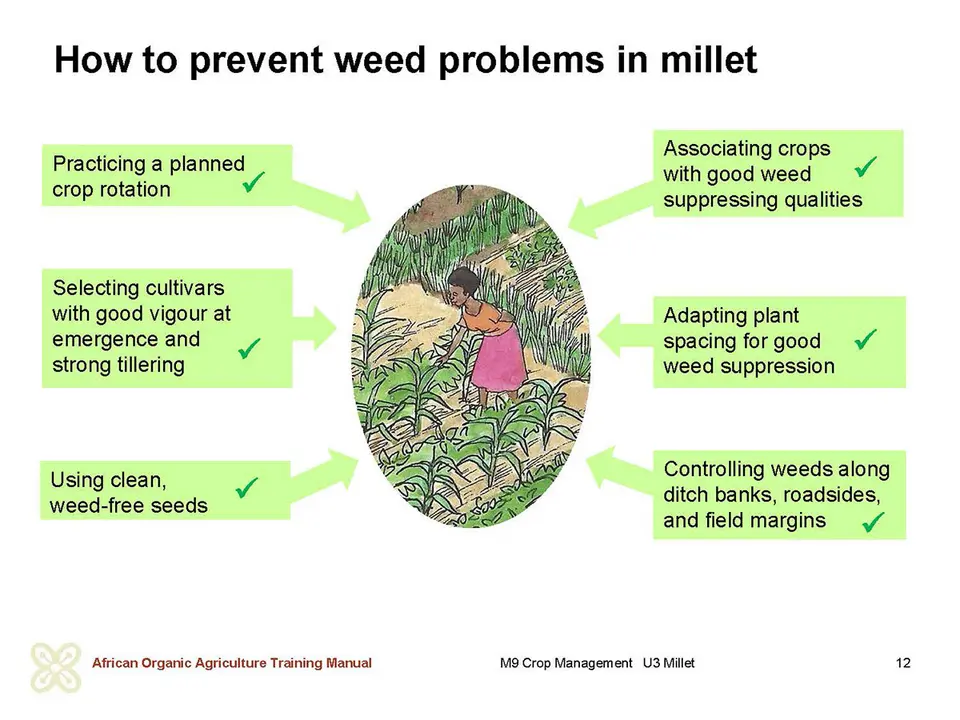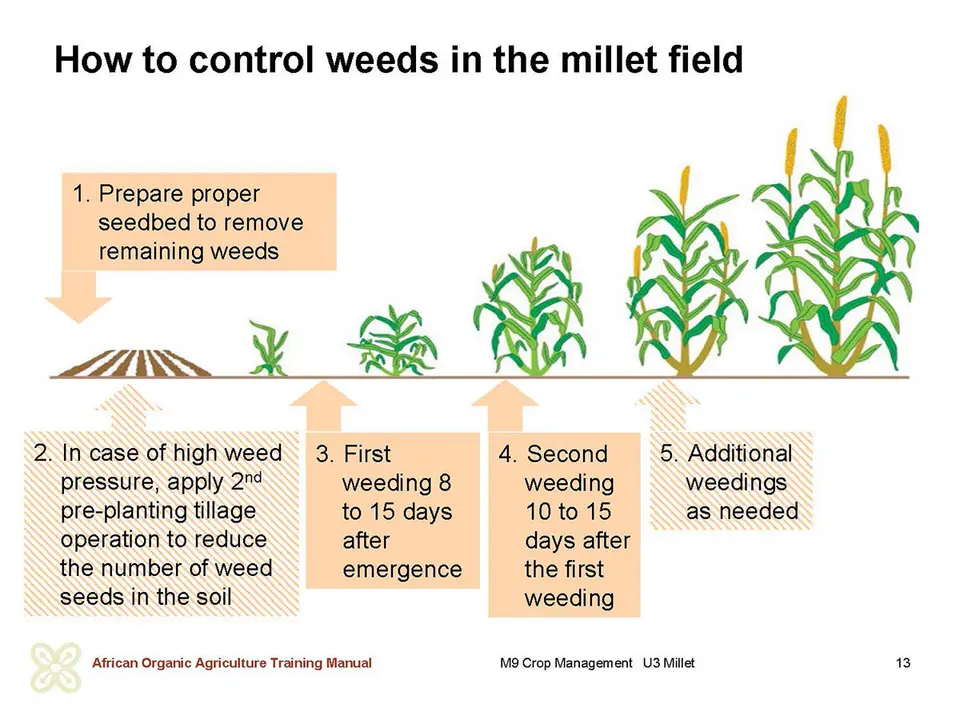Proper weed management
Millet has a rather slow early growth and does not rapidly develop a dense canopy cover, which can help to smoother weeds. This makes the crop sensitive to competition by other plants during this time. Weed competition in early growth results in yield loss. Thus, weed control prior to planting and until the crop has fully established is important. When the millet plants have produced enough biomass, they compete well with late-emerging weeds, when grown in dense stands.
Weed control options in organic millet production
Conventional farmers rely on the use of herbicides for weed control, when the need arises. Organic farmers strive for optimizing non-chemical preventive and direct measures to control weeds. The use of herbicides is not allowed in certified organic agriculture.
a) Preventive measures
Preventive measures include i) using clean, weed-free seeds, ii) associating millet with crop(s) with good weed suppressing qualities, iii) choosing appropriate spacing, iv) selecting cultivars with good vigour at emergence and strong tillering, and v) applying proper crop rotation. Controlling weeds along ditch banks, roadsides, and field margins will also help prevent weed seeds from infesting the fields.
b) Mechanical control
Before sowing millet, any weeds present in the field should be removed through proper seedbed preparation. Crop residues and the removed weeds can be used to cover the soil as mulch or can be aligned at intervals as trash lines in order to cover the soil in between the rows and hinder new weeds from growing. Alternatively, the weeds can be collected and used for making compost, but care must be taken not to disperse weed seeds and diseases through the compost, if the compost is not well prepared. In case of high weed pressure additionally a pre-plant tillage operation is recommended to kill the weed seedlings prior to planting and to reduce weed pressure in early growth of millet. Light harrowing after emergence can help to control early weeds.
For good cultural practice, two weeding and thinning-out operations are usually necessary in millet. Eight to fifteen days after emergence (preferably after rain) the field should be thinned to 2 to 4 plants per station. When weeding by hand thinning is usually combined with weeding. The first weeding should be no later than 15 to 20 days after emergence. The second weeding should be done manually and follow the first by 10 to 15 days, but could vary depending on weed pressure. Thereafter, additional weeding should be performed as needed.
Weeding is commonly done with a hoe, but animal-drawn or tractor-drawn cultivators can be used, too. In case a drawn cultivator is used for inter-row cultivation, the weeds between plants within the rows are removed by hand. Broadcast millet can be mechanically weeded using a tine-weeder (a harrow with spring steel tines). Tine-weeding is very effective between sowing and plant emergence (called blind harrowing), as well as when the millet plants have three to four leaves and the weeds are not taller than 1 cm.
c) Cultural control
Planned rotation or intercropping of millet with leguminous crops or green manures will prevent the build-up of weeds, including Striga. Striga does not do well in soils with a good fertility status. The combination of different weed management practices will most effectively reduce weed proliferation.
Controlling the Striga weed
Striga hermonthica (witch weed) is a parasitic weed, which is problematic in many cereal producing areas of Africa. Striga competes with the millet plants for both water and nutrients. Consequently, low soil fertility and low rainfall favour Striga infestations. To prevent Striga from spreading, farmers should plant uncontaminated seeds and clean off soil and plant debris from machinery, shoes, clothing, and tools before entering fields. If the Striga plants are few, pulling-out the weed before it produces seed is an option, but not a long-term solution. Another method called trap cropping involves planting a species in an infested field that will induce the Striga seeds to germinate but will not support attachment of the parasite. Example of such crop is plumed cockscomb (Celosia argentea) planted in rotation with millet. The plumed cockscomb will ‘trick’ the Striga seed to germinate, but will not support any further growth of the weed seedlings. This helps to deplete the Striga seed bank in the soil while preventing formation of more seed by the weed. Other crops that are claimed to be effective against Striga include cotton, sunflower, groundnut, castor, dolichos bean, and linseed. In the push-pull system Desmodium species (silverleaf, D. uncinatum and greenleaf, D. intortum) are used to repell the stemborer moths. The same Desmodium species also control Striga.
Discussion on weed management in millet production
Ask the farmers whether they experience any major weed problems. List the local names of major weed species and identify their characteristics.
Inquire about local weed control strategies that are being used and discuss potential improvements.


 tap and then scroll down to the Add to Home Screen command.
tap and then scroll down to the Add to Home Screen command.